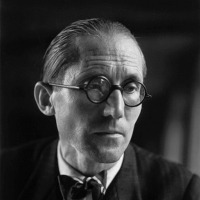Le Corbusier. Architect, city planner, painter, interior designer, writer, editor, photographer and amateur film-maker. Le Corbusier was a multidisciplinary artist who amazed the world with his creative power and unconventional ideas. Through 200 objects illustrating the full dimensions of his creative processes, the exhibition Le Corbusier: An Atlas of Modern Landscapes explores the many facets of an artist regarded today as a key figure in 20th-century architecture. The result is a truly extraordinary experience, the most complete exhibition devoted to the architect in our country in the last twenty-five years. This comprehensive retrospective traces Le Corbusier’s life and work over a sixty- year career in which he constantly observed, imagined and created landscapes: architectural landscapes, domestic landscapes and found object landscapes. Organised by the Museum of Modern Art (MoMA) of New York and featuring many pieces loaned by the Fondation Le Corbusier in Paris, the exhibition includes not only models, paintings, plans and photographs, but also four recreations of rooms, complete with their original furniture. The show also focuses on Le Corbusier’s links to the city of Barcelona, as well as featuring several panoramic photographs taken by Richard Pare of some of the architect’s most outstanding projects.
Madrid, 10 de june de 2014. At CaixaForum Madrid, Elisa Durán, assistant general manager of ”la Caixa” Foundation; Ramona Bannayan, Senior Deputy Director for Exhibitions and Collections at the Museum of Modern Art (MoMA), New York; Michel Richard, director of the Fondation Le Corbusier; Jean-Louis Cohen, Sheldon H. Solow Professor in the History of Architecture at the Institute of Fine Arts, University of New York, and the exhibition curator; and the photographer Richard Pare will attend the official opening of Le Corbusier: An Atlas of Modern Landscapes, the most comprehensive retrospective ever devoted to the architect in our country in the last twenty-five years.
The show forms part of the firmly consolidated exhibition programme that ”la Caixa” Foundation devotes to architecture. This programme goes beyond the focus on particular styles and historic periods to provide visitors with an overview that enhances their understanding of the role that architecture plays in the world around us.
Particularly outstanding amongst the shows organised so far are those devoted to such great masters as Mies van der Rohe, Andrea Palladio and Richard Rogers, and recent projects like Building the Revolution: Art and Architecture in Russia 1915-1935 and Towers and Skyscrapers: from Babel to Dubai.
Now, Caixaforum presents Le Corbusier: An Atlas of Modern Landscapes, organised by the Museum of Modern Art (MoMA) of New York in cooperation with the Fondation Le Corbusier in Paris and produced by ”la Caixa” Foundation. The most comprehensive retrospective that MoMA has ever devoted to the architect, this show was visited by more than 400,000 people from June to September last year. Now the exhibition comes to CaixaForum Madrid.
The exhibition features 200 objects that encompass all the facets of the creative processes of this great all-round artist (La Chaux-de-Fonds, Switzerland, 1887 – Roquebrune-Cap-Martin, France, 1965).















































